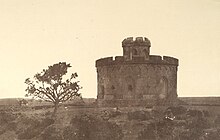Flagstaff Tower
The monument is still preserved and in very good condition. This cemetery, where the few British who fell during the uprising are buried with their leader, Brigadier John Nicholson, is now that well preserved that a Britain's High Commissioner, Mr. Michael Arthur, who once helped in the restoration and repairing of the cemetery thought that it surpassed many of the cemeteries in Britain, with its beautiful glimpse of the history of the year 1857.
History


Flagstaff Tower played an important role during the Indian Rebellion of 1857, when Delhi was captured by the rebellious East India Company forces. On the morning of 11 May 1857, when the sepoys started hunting for and killing European personnel and Christian Indians in the Cantonment, Civil Lines and the walled city of Delhi, the survivors started fleeing towards the Tower.
A month later the Company army returned to capture Delhi, which was now with the sepoys. On 7 June, they faced stiff resistance from the sepoys at the Flagstaff Tower. A fierce battle followed which led to the killing and wounding of a great number of soldiers. However, by five in the evening the ridge had been recaptured and was now under British control.
Architecture
Inside the tower, which is locked, there is a circular room that can hold a crowd of up to a hundred people. It resembles a mini fort but not that safe. In recent times some parts of the tower have been ruined due to people having scribbled on its wall. Before deforestation in the year 1910, the area where the tower was built was the point on the ridge and was mostly barren and covered with small-sized shrubs.
See also
References
- ^ "Flagstaff Tower, Old Delhi". victorianweb.org. Retrieved 5 September 2012.
- ^ "DU plans a heritage walk through the Ridge". The Hindu. 13 August 2012. Retrieved 5 September 2012.
- ^ "Tales of the ridge monuments". The Hindu. 29 July 2012. Retrieved 5 September 2012.
- ^ Jones, p. 203
- ^ Smith, R. v (29 July 2012). "Tales of the ridge monuments". The Hindu. ISSN 0971-751X. Retrieved 30 September 2021.
- ^ City, So (24 September 2017). "Built By The British As A Signal Tower, Have You Noticed The Flagstaff Tower On Kamla Nehru Ridge?". So City. Retrieved 30 September 2021.
External links
- Rosie Llewellyn-Jones (2007). The Great Uprising in India, 1857-58: Untold Stories, Indian and British. Boydell & Brewer. ISBN 978-1843833048.
- William Dalrymple (2006). The Last Mughal: The Fall of a Dynasty, Delhi 1857. Penguin Viking. ISBN 0670999253.
- Flagstaff Tower at wikimapia